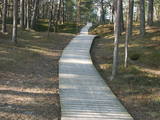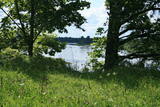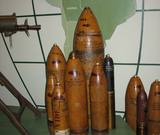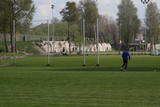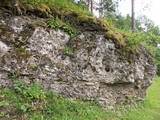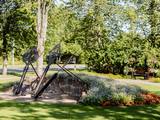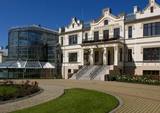| Nr | Name | Beschreibung |
|---|---|---|
|
Tītuvēnu reģionālais parks (Tytuvėnų regioninis parkas) dibināts 1992. gadā. Parkam raksturīga ainavu daudzveidība – te ir sastopami lieli mežu masīvi, purvi, ezeri, upītes. Šejienes reljefa veidotājs tāpat kā citur Baltijas valstīs ir bijis ledājs, kas atnesis un atstājis aiz sevis garas laukakmeņu grēdas. Kopumā parkā ir konstatētas 603 augu un 787 dzīvnieku sugas. Parkā aug veci un dabiski boreālie (ziemeļu) meži, veci un jaukti platlapju meži ar ozoliem, liepām, kļavām, ošiem un gobām, sugām bagāti egļu meži, staignāju meži, nogāžu un gravu meži, purvaini meži un aluviālie (pārplūstošie) meži. Parkā esošās pļavas un tīrumi ir nozīmīga dzērvju atpūtas vieta migrāciju laikā, kad te pulcējās tūkstošiem putnu. Šiluvas baznīca un Tītuvēnu klosteris ir svētceļnieku galamērķis vairāk nekā 500 gadu garumā. |
||
|
At the estuary of the Inčupe River, there is the White Dune, which is around 18 metres high and is the most lovely element of the Vidzeme shoreline among those that have been created by the wind, sand and sea. There is a wooden footpath (the Saulriets trail) which is meant to view, but also protect the dune. It has a viewing area, too. The territory to the south of the river is in the Piejūra Nature Park.
|
||
|
Einer der bekanntesten Sandsteinaufschlüsse in Lettland mit einer Echo-Felswand (etwa 12 m hoch). Am rechten Ufer der Salaca wurde ein Rastplatz angelegt, an dem man ein Experiment durchführen kann: Man stellt sich dem Aufschluss gegenüber hin und spricht nur halblaut. Das Echo kann der Sprecher selbst und alle anderen auf dem Platz hören. Die Objekte befinden sich im Naturpark Salaca und im Park Skaņaiskalns.
|
||
|
Dieses Territorium schützt die Biotope der Küstendünen und der Dünen von Plieņciems, die sich über die ganze Strecke bis nach Ķesterciems erstrecken. Das ist ein vielbesuchtes Gebiet, aber das Objekt Plieņciems wurde nicht ausgebaut. Es gibt jedoch einen hölzernen Fußweg durch die Düne zwischen Plieņciems und Ķesterciems. Hier wurde auch ein Erholungsgebiet errichtet.
|
||
|
Ein bedeutender Ort der lettischen Geschichte, denn hier befand sich im 12. und 13. Jh. das amtliche und auch kulturelle Zentrum des alten lettgalischen Landes Jersika mit der Burg des Herrschers Visvaldis am 18m hohen Ufer der Daugava, wo sich der mächtige Burghügel erhebt. |
||
|
Am westlichen Ufer des Cirma Sees erhebt sich die 1830 von Feldsteinen erbaute Kirche. Ein berühmtes Gemälde der Jungfrau Maria, dem Wunderkräfte zugeschrieben werden, macht das Gotteshaus zu einem beliebten Wallfahrtsziel. |
||
|
The craftswoman produces beautiful rag blankets, bags, as well as pillows with ranges and combinations of colours that are typical in Latgale. You will learn about the weaving techniques and be able to examine finished products. You can weave your own rag blanket and commission and purchase the products. |
||
|
Das Museum befindet sich im Pulvertornis, der in der Zeit des Mittelalters in Riga eine sehr bedeutende Bestandteil des Fortifikationssystems der Stadt war. Das Grundthema des Museums ist die miltär-politische Geschichte Lettlands und die objektbezogene Exponate.
|
||
|
The “Lamb Club” is a farm in Mazsalaca, and it is special because the sheep live in a real club! The owners offer the atmosphere of a farm at which the sheep play major roles. Enjoy mutton and sheep milk foods and beverages, feel how comfortable it is to read your favourite while sitting on a fluffy sheepskin, and, in order not to get cold by the campfire in the evening, you can purchase warm woollen socks and woven woollen cloaks. The owners hope that people from Latvia and all around the world will spend more time at the farm, because accommodations involve a new glamping tent that is as close as possible to nature and the healthy rural environment. Don’t lose a lick of the comfort that you are used to in your everyday life! The owners, Ilze and Valters, will be happy to give you a tour during which they talk about herding sheep. If you contact them in advance, they will prepare a tasty mutton meal for you. The tour can also be supplemented with various activities such as games, quizzes and creative workshops at which sheep wool is utilised. |
||
|
Diese Gaststäte liegt an einem landschaftlich sehr schönen Ort – im Urstromtal des Flusses Abava, zwischen Kandava und Sabile. Die Gaststätte befindet sich in einem historischen Gebäude mit einem Mantelschornstein, der einer der größten im Baltikum ist. Nebenan befindet sich eine Erholungsstätte für Wassertouristen. Lettische Küche: Kalte Rote-Beete-Suppe, Suppe aus Fleischbällchen, Ampfersuppe, Sauerkrautsuppe, Hähnchenleber, hausgemachte Frikadellen, geräucherte Schweinerippen, gebratenes oder gegrilltes Schweinefleisch, Kartoffelpfannkuchen mit Sauerrahm, dünne Pfannkuchen, Kräutertees. Das besondere Gericht: Mit geräuchertem Fleisch, Quark und Zwiebeln gefüllte Klöße. |
||
|
Daugavpils – Krāslavas (A 6) ceļa malā redzamais dievnams uzcelts ar Plāteru dzimtas pārstāvju – Vaclava un Kazimira Plātera atbalstu 1811. gadā. Dievnamu ieskauj metālkaluma un no ķieģeļiem mūrēts žogs, kā arī divi zvanu torņi. Labās puses zvanu tornī karājas vecs zvans. No baznīcas iekārtas ir jāpiemin galvenais altāris, ko rotā Dievmātes skulptūra, trīs biktskrēsli, četras evaņģēlistu sienas freskas un Lurdas Dievmātes glezna. Ikdienā apskatāma no ārpuses. |
||
|
Guest house “Hilda Villa” is located in Estonia, in Viljandi town center. Guest house has special family room for 4 person and smaller families also. On the first floor there are Hilda's room and the Tenant's room, bathroom, living room, and kitchen. On the second floor there are 3 bedrooms for accommodation, 2 showers, and 2 toilets. |
||
|
Ein Gebiet zwischen Palanga und Klaipeda, gegründet für den Schutz der Dünen und Biotopen der Küstenwälder. Ein asphaltierter Radweg läuft durch das Gebiet. |
||
|
Saimniecība "Baltiņi" atrodas Auces novadā un nodarbojas ar lopkopību un lauksaimniecību. Viesiem ir iespēja redzēt un izzināt piena ražošanas procesu, kā arī iepazīt saimniecības dzīvniekus. Saimnieki piedāvā apskatīt padomju laiku auto kolekciju, pieejama arī suvenīru un trauku kolekcija ar govs motīviem. |
||
|
Ein kleiner Teil von dem beeindruckenden Fortifikationssystem von Liepāja, das die Stadt die Küste der Stadt umgibt. Er befindet sich am Stadion „Olimpija”. Siehe auch die Objekte Nr. 30077, 30078, 30079, 30080, 30098.
|
||
|
Hier kann man eine breite Sammlung an alten Musikinstrumenten besichtigen. Die Besucher können den Erzählungen über die Geschichte und Herstellung von Musikinstrumenten zuhören, sowie selbstgemachte Musikinstrumente bestellen und kaufen. Mit vorheriger Anmeldung kann man das Konzertprogramm der Kapelle der Familie von Igaunis anhören. |
||
|
Das ist ein Abschnitt des Gauja – Flusses mit Stromschnellen an einigen Stellen. Es erstreckt sich von Vidaga bis zum Ort, wo der Fluss Vecpalsa indie Gauja fließt. Entlang der Gauja und seinen Nebenflüssen kann man Dolomitaufschlüsse an seinen Ufern sehen, die größten sind die Randati – Klippen. Das Territorium wurde vor allem eingerichtet, um die verschiedenen Arten an Wald, Wiesen, Aufschlüssen und ihre Habitate zu schützen. Das ist ein interessanter Abschnitt des zentralen Teils der Gauja, vor allem für Leute, die die schöne Landschaft genießen möchten und für Wassertouristen.
|
||
|
The key treasure in this park is that it has a lake that is one of the most intensive sites for birdwatchers in all of Latvia. It also features outstanding flora and the shallow waters of the Bay of Rīga. Recommended: Hike along the seashore from Mērsrags to Engure (20 km). See wild domestic animals (horses and cows) on the eastern shore of Lake Engure. There’s a bird-watching tower on the NW shore of the lake (approach from Kūļciems, where you can see domestic animals adapted to life in the wild, including the Blue Cows of Latvia). A bird-watching tower can be found at a place called Jomiņa near Mērsrags, where the seashore meadow is an uncommon biotope
|
||
|
Parkā blakus pusloka tiltiņam ir novietotas trīs milzīgas dzelzs atslēgas, kuras balsta akmens mūris un metāla arkas. Tās simbolizē trīs vēsturiskos centrus un to vienotību – Siguldu, Turaidu, Krimuldu. Dobēs pie šī objekta sezonāli zied dažādi kultūraugi. |
||
|
Der Schlosspark Kretinga ist einer der ältesten erhaltenen Schlossparks in Litauen, datierend aus dem 16. bis 18. Jahrhundert. Der Park hat eine Fläche von 23 ha und ist stilistisch gemischt. Im Südteil des Schlossparks Kretinga ist an der Stelle der ehemaligen Obstplantage jetzt ein astronomischer Kalender mit Sonnenuhr aufgestellt. Ferner gibt es hier viele Hecken, Allen, Blumenrabatten und Alpinarien. Sammlungen aus Dahlien, Pfingstrosen und Tulpen werden gehegt und man ist mit der Wiederherstellung des einstigen Rosengartens, der Wege und der Plätze zum Ausruhen beschäftigt. Der bereits restaurierte Springbrunnen des Schlosses wurde zu einem bei den Gästen sehr beliebten Erholungsort. |
||




